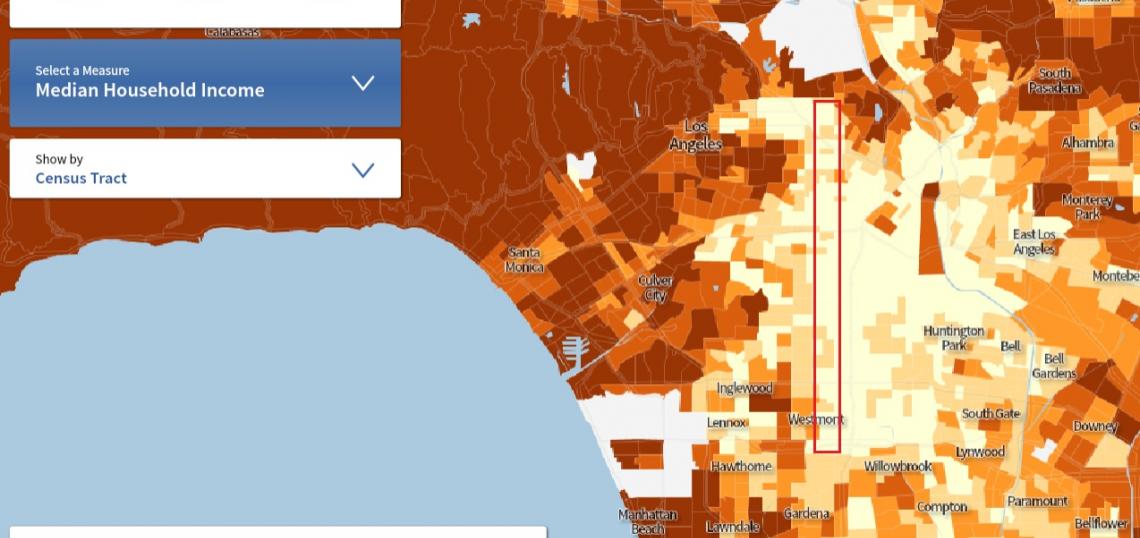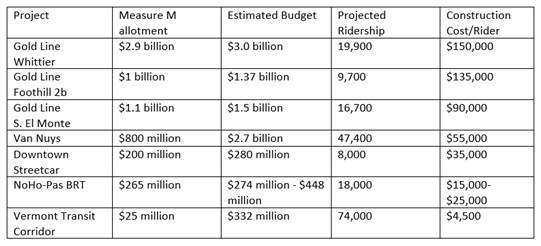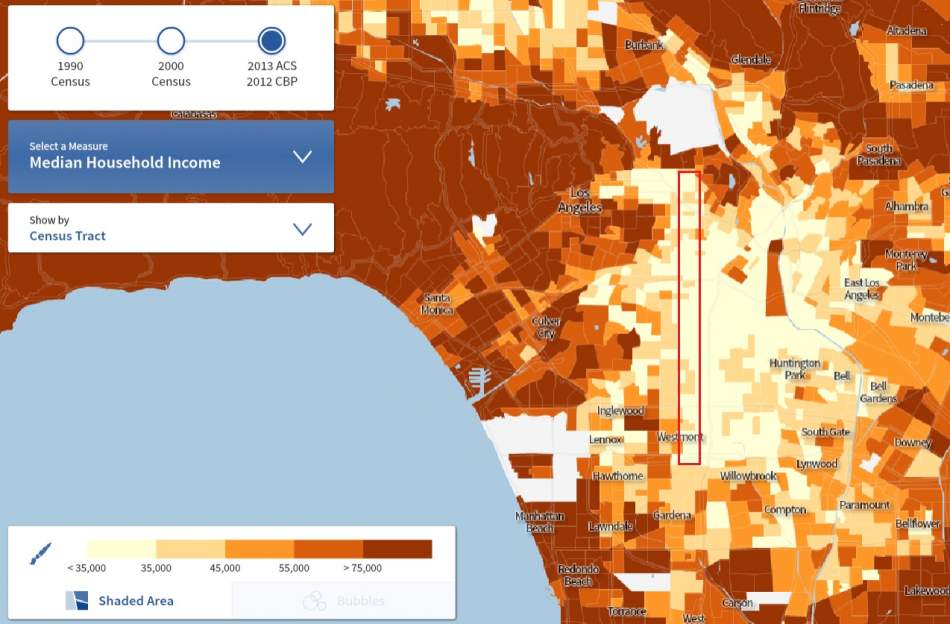Efforts to bring bus rapid transit to Vermont take another step forward this month with the presentation of conceptual build alternatives to one of Metro’s service councils. The term is frequently used in ambiguous ways by transit agencies, but the core plan here consists of all-day bus only lanes on Vermont, with the option of four miles of center-running operations. More streets in Los Angeles need to look like this, with capacity wrested from cars and reserved for public transportation. In the Overbuilt Arterials Playbook, this should be the opening gambit every time. By avoiding the rightmost lane, and instead taking a lane of general traffic, Vermont can hopefully avoid the pitfalls that have plagued Wilshire’s peak-hour bus lanes. Despite projections that the bus-only lanes on Wilshire would increase average speeds to 15 mph, Metro’s timetables indicate that the 20 and 720 are actually slower now than before implementation. The Vermont proposal is a step in the right direction, because it attempts to disentangle buses and right-turning cars, which should help improve speeds in a non-trivial way.
If there is a problem here, it’s that the plan also amounts to a doubletake-inducing underinvestment in a part of the city that has been ravaged by underinvestment for decades. Concepts 1 and 2 are projected to attract 74,000 daily riders, a total which might have made Vermont a marquee project for inclusion in Measure M. Instead, bus funding just barely squeaked in, while rail was passed off, not for the first time, as a problem for next century.
This has more to do with the city of Los Angeles than it does with Metro. The city initially included a “short” subway extension of the Red Line from Wilshire to Expo in its mobility matrix, estimated at just under $2 billion for 3 miles. Los Angeles wanted $425 million in local match funding for the extension, which eventually became $25 million in dedicated Measure M funds for bus-only lanes with an expectation of locking down $400 million in funds elsewhere.
The “bottoms-up” process for establishing Measure M’s project list gave localities broad license to determine their own priorities, and this was especially true for the city of Los Angeles, which comprises all or part of four of Metro’s designated subregions. Mayor Garcetti was preoccupied with wooing San Fernando Valley voters, who had been vocally discontent with the results of Measure R. This is evidenced in, for example, the mayor’s last minute motion to add Bus Rapid Transit for Nordhoff to the front of the spending line. But it also can be seen in the way that spending took shape for the Central City subregion.
The funding pot for this subregion, which includes the neighborhoods of Central and South Los Angeles, was used to further entice voters in other parts of Los Angeles. In the final expenditure plan, the Central City allocated $1.8 billion to transit projects, and about $2.2 billion to citywide initiatives. The process was necessarily rife with political calculations, and, presumably, the voters in Central Los Angeles were considered to be a lock to vote yes. Still, though, that doesn’t explain how the Vermont Corridor got less dedicated funding than the downtown streetcar. The differences in projected ridership and benefit per user are profound. In fact, both in absolute terms and in terms of construction cost per projected rider, Vermont gets very little compared to other corridors.
Given the maneuverability of the subregional funds, it seems like $425 million for the Red Line short subway could have been drummed up through internal redistributions of Central City expenditures. All that was missing was an advocate. It’s likely that councilmember Jose Huizar was instrumental in the inclusion of money for the streetcar, just as State Senator Bob Hertzberg was for the CSUN-serving Nordhoff BRT. Overall, very few projects that actively sought funding failed to receive it. The Measure M pie was made bigger and bigger until everyone could have a piece.
That Vermont is where the line was drawn is telling. The corridor is dense, transit-dependent and impoverished. As can be seen in census data, Vermont is the major North-South artery of an unbroken string of low-income neighborhoods.
The failure of the process to provide more significant funding for this deserving community can also be traced to the problematic absence of a formal COG structure for the Central City subregion. However flawed the COGs might be, in other parts of the county these bodies post agendas, hold meetings and serve as a point of communication for residents. It can be seen that in the Central City, local projects were undervalued without this mechanism in place.
And, indeed, the Vermont subway has a considerable value as transit project. Vermont is primed for a rail extension. The five bus routes that travel on Western, Normandie and Vermont between the Green Line and Hollywood Boulevard are heavily-traveled, with Vermont and Western being, respectively, the second and third busiest bus routes in the county. On an average weekday, 86,000 boardings are logged within this corridor, a total which, like Metro’s bus ridership overall, is down 20% since 2009 when there were 105,000 daily bus boardings. These numbers suggest a potential just below some of the projects Alon Levy identified a few years back as receiving less official attention than their potential merited. Among these were Utica Avenue in New York with 120,000 bus boardings on nearby parallel routes, Geary in San Francisco with 113,000 parallel boardings, and 125th Street in New York with 90,000 parallel boardings.
The major difference between Vermont and these others is that the other three candidate rail lines mentioned are much shorter than the 10 miles between the Purple and Green Lines, making it more cost-effective to serve those riders. On the other hand, the primary travel pattern on the Vermont buses is that riders travel from south of Wilshire north to the Red and Purple Lines. If a Red Line extension south on Vermont provided a significant increase in speed over existing service, then it would probably attract the available boardings within the corridor. The question for the cost-effectiveness of the extension is how far the Red Line would have to extend before there was a material benefit to long distance bus-riders in transferring to the train.
The Metro staff report estimates that it presently takes 70 minutes for buses to travel from Hollywood Boulevard to 120th Street during peak hours. Google agrees, and the trip can be broken down into three segments of roughly equal travel time: from Hollywood to Wilshire, from Wilshire to Expo, and from Expo to the Green Line.
These segments are equal in travel time, but not in length. Buses are moving almost twice the speed south of Expo as they do north of it. Furthermore, due to the heavy traffic, even the short subway extension would be expected to save bus riders 16-17 minutes between Wilshire and Expo if it took trains 6 minutes to travel that stretch. After allowing for two minutes of transfer time from the bus to the subway and two minutes of wait time for the train, the resulting trip is significantly improved compared to the bus-only trip.
With that, I feel comfortable saying the short subway is long enough to be successful. In fact, it has several benefits in addition to saving time for 204/754 bus riders that get on further south. It connects the Red Line to USC, creating an easier connection for southbound riders from Hollywood and the Valley. It will also generate new ridership by improving transit access for the dense residential neighborhoods of Koreatown, Pico-Union and University Park.
The southern portion of the route is dense by Los Angeles’ standards, but less dense than north of Expo. The merits of continuing a rail extension all the way to the Green Line are primarily in providing benefits directly to what is probably the most isolated pocket of poverty in the county. As a plus, it would also be cheap for a new rail extension. South of Gage, the wide right-of-way would allow for elevated rail to run in the median of Vermont down to the Green Line. Not only does this mean significantly cheaper construction, but also that Metro could fund this chunk of 4.5 miles down to El Segundo Boulevard in Gardena with help from Propositions A and C. These two taxes, which were used to construct the current Red and Purple Lines, have set-asides for the construction of rail, but have been prohibited for use on below-grade rail since the Red Line reached North Hollywood.
Of course, at present, there’s no money to get the Red Line down to Gage, or to Expo, for that matter. If the city of Los Angeles were to get into the business of helping to fund high-ridership transit lines within its borders, as I think it should, the Red Line extension to USC would be a top priority. Measure M’s prospects of passing were viewed as questionable, so it’s somewhat understandable that support had to be shored up in the suburbs. Now that the tax has passed, though, it should be incumbent upon Los Angeles to share the resulting wealth with communities that were bypassed in that effort.
Between the four Metro sales taxes, the city of Los Angeles will receive $250 million in local return dollars in the next fiscal year, an amount that will grow over the decades to come. If some part of that revenue stream could be used to sell bonds for even a portion of the cost of the extension, that local funding could be used to attract enough federal or state dollars to complete the project. The route is contained within not one, but two federal Promise Zones, a designation intended to help disadvantaged communities compete for federal dollars. Los Angeles’ in-need neighborhoods have not gotten some notice nationally, but, if this transportation link is going to get built in this lifetime, it still needs a leader willing to fight for it locally.
- Metro Archive (Urbanize LA)
Scott Frazier is a graduate student at Cal State University Los Angeles in Public Administration. Follow him on Twitter @safrazie.








